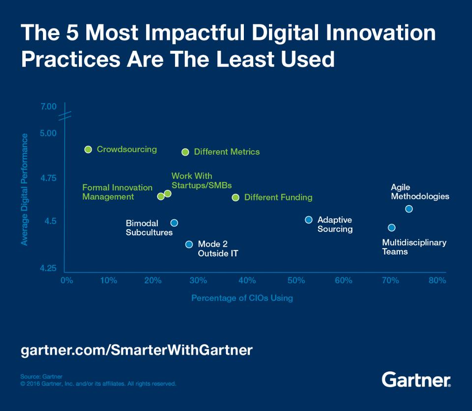Going agile has been the mantra of so many companies but what are other digital innovation investments that can be even more impactful? What follows are the Best Kept Secrets in Digital Innovation Next Practices.
Many CIOs are guiding companies to adopt an agile approach in all product and service delivery processes. The strategy makes perfect sense and is relatively easy to adopt and push out especially to smaller teams. Going agile has definitely made great strides in IT and software development teams and the focus has shifted on how the rest of the organization can also adopt an agile mindset.
Achieving sustainable innovation remains as the toughest nut to crack. Organizations that want to thrive in this era of continuous change want to invest in systems that are capable of impacting the enterprise as a whole by embracing continual insights from employees and tapping into a wide range of outside voices including customers, suppliers, partners, start-ups, universities and their community.
Gartner’s CIOs survey take on the most impactful digital innovation next practices really hits the mark on this reality. The survey, conducted with over 3,000 CIOs, finds that the following digital innovation next practices are the least used but yield the highest ROI:
1- Crowdsourcing
2- Different Funding (encouraging disciplined experimentation)
3- Different Metrics (reward learning and responsiveness)
4- Working with Startups
5- Formal Innovation Management
An agile innovation approach would address all of the above areas and help build a systematic approach to operationalize innovation management.
It is also interesting to note that the agile ethos perfectly fits these top 5 digital innovation hacks to drive the thinking and approach necessary for getting an even better ROI from these practices. Let’s review each of these in more detail.

Crowdsourcing
Take a challenge driven innovation approach to problem solving with the right community. This allows the organization to obtain creative ideas that are strategically aligned and helps the organization achieve its corporate objectives. An average of 60 percent of all projects are not aligned with business strategy. You will reap amazing rewards by focusing your efforts on your most important goals. Social collaboration through this practice improves employee engagement, drives better results for your voice of the customer program, and nurtures the right working environment to deliver on your design thinking initiatives.
Different Funding
Make experimentation the heart of how your company operates. Make sure you have smaller agile projects that are really treated as low cost experiments you can learn from as quickly as possible. 61% of your projects are going to be challenged or fail so redirect some of these funds to these experiments. You will end up with better scoped projects that are much more likely to deliver the results you expect.
Differentiated Metrics
As the world is changing around us so should the measurements and metrics we use to track progress and declare success. Organizations realize that being totally risk averse is not an option. Instead the focus must turn to embracing risk and experimenting cost effectively, learning from failure and moving towards the the desired outcomes.
Working with Startups
Every successful organization should establish a framework for assessing strategic fit and potential collaboration with start-ups. Companies in every industry are facing disruptive challenges that they can no longer afford to ignore. The start-ups that are taking aim at their business are growing quickly, attracting new capital and talent, and adding new customers at a record pace. Designing an agile model to evaluate specific start-ups in a collaborative manner will have a major impact on the way your company competes and grows its business. You should systematically identify, discover and assess technology, service providers and new business models based on what they offer and how well you might be able to partner with them. Implement an agile model for selecting software, hardware and service providers that fit your strategy, business criteria and objectives, and potentially join forces with these providers by quickly bundling their solutions as part of a coherent integrated offering.
Formal Innovation Management
This last one really helps you bring all of the above practices home so you can continue to reap the associated benefits consistently and in a sustainable manner. By operationalizing your innovation processes end to end you can continuously listen, identify, ideate, collaborate, evaluate and experiment. This practice creates the culture, discipline and systems that will ensure higher ROI and the right approach to manage your innovation funnel. A lot of attention is now focused on differentiation, maintaining the competitive advantage and clearly defining your economic moat. Implementing a challenge-driven innovation model and formalizing your idea management process will allow you to turn creative ideas to winning projects.
The world we now live in requires us to continually review, adjust and sometimes redefine our strategy. To meet this incredible challenge how can you get there if you are doing the same thing everyone else does?

